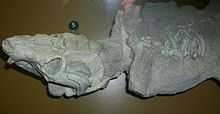Probainognathia
The Probainognathians are members of one of the two major clades of the infraorder Eucynodontia, the other being Cynognathians. They were mostly carnivorous, though some species may have evolved omnivorous traits. The Probainognathia are split into four groups: Probainognathidae, Chiniquodontidae, Tritheledontidae, and Mammaliaformes. The earliest and most basal Probainognathian is Lumkuia, from South Africa. Non-mammalian probainognathians lived from the Triassic to the Jurassic, making this clade one of the longest lived therapsid family.
Classification
Taxonomy
Phylogeny
Below is a cladogram from Ruta, Botha-Brink, Mitchell and Benton (2013) showing one hypothesis of cynodont relationships:[1]
See also
References
- ↑ Ruta, M.; Botha-Brink, J.; Mitchell, S. A.; Benton, M. J. (2013). "The radiation of cynodonts and the ground plan of mammalian morphological diversity". Proceedings of the Royal Society B: Biological Sciences 280 (1769): 20131865. doi:10.1098/rspb.2013.1865.
|
|---|
| | | | | | | | |
|---|
| | |
|---|
| | | |
|---|
| | | | Trirachodontinae | |
|---|
| Sinognathinae | |
|---|
|
|---|
| | |
|---|
|
|---|
|
| | | | |
|
